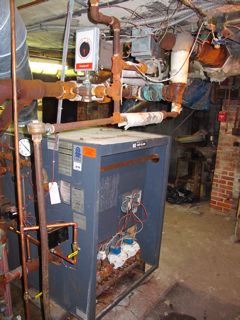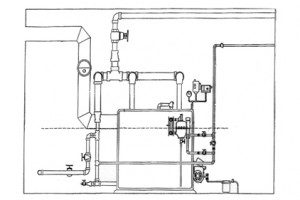We always have turkey for Thanksgiving. I mean who doesn’t? My job wasn’t to cook it, though; it was to eat it.
Zoning Steam Systems

A gravity-return steam system uses a combination of two forces to put the returning condensate back into the boiler.
First, there’s the steam pressure that's leftover at the end of the mains. Now, this pressure will never be as great as the pressure that’s inside the boiler because as steam travels through the pipes it loses some of its energy to friction. What you wind up with at the end of the main depends on the size of the pipes and the boiler’s load. This has all been figured out years before you were born by the Dead Men.
The other force that works to put the returning condensate back into the boiler is gravity. Gravity combines with the leftover steam pressure at the end of the main to create a force that’s greater than the pressure inside the boiler. The Dead Men allowed enough vertical space between the end of the lowest steam main and the boiler’s water line to give the returning condensate a place to stack up. That's what most folks in the business call, "Dimension A." Gravity takes over and the condensate slides back into the boiler. It’s all very simple, and it has been for years.
But now, someone shows up and adds their motorized zone valves to piping that's leaving the steam boiler. They figure that this will be a neat way to save fuel dollars. They're wrong, but you've met people who are wrong before, haven't you? Some of them can be very convincing!
Anyway, these valves will work beautifully - as long as they never close. As soon as one or more does close, however, that "leftover" steam pressure that you were depending on to put the condensate back into the boiler disappears. Now, all you have going for you is gravity, and that’s not enough to put the returning condensate back into the boiler. So the condensate backs up into the main and lies there, waiting for that evil motorized valve to reopen.
And when Mr. Valve does reopen, Mr. Steam comes raging through, meeting Mr. Condensate and sending him rocketing toward the end of the main where he lands with enough force to knock the building off its foundation.
Perhaps you've heard this noise?
But this isn't the only problem. Keep in mind you have a burner on that boiler that’s sized to provide steam for the entire building. When any motorized zone valve shuts, the firing rate doesn’t change, does it? Suddenly, you have more steam volume than the pipes can handle. Too much steam volume means the steam will move at a higher velocity, and at the higher the velocity, the faster the steam will suck water out of the boiler. That, of course, leads to water hammer in the zones that are calling for heat.
Perhaps you've heard THAT noise? Oh, that's a BIG noise!
But wait, there's more. As the water goes flying into the pipes, the boiler begins to drop into a low-water condition. Bound to happen, right? The burner shuts off, but before the condensate can return, the automatic water feeder kicks in and adds water to a system that doesn’t really need more water. When the condensate finally returns from the system, the boiler floods.
You blame the automatic water feeder for this. The feeder is absolutely innocent - but also convenient.
What's next? Oh, someone decides to install a check valve in the wet return. That person figures that a check valve will keep the water from backing out of the boiler. On the day that the check valve goes in, the water stops backing out of the boiler. Problem solved?
Nope. It's really just beginning. Now the condensate can't get back into the boiler because there’s not enough pressure to open the check valve. The water hammer continues its psychotic banging whenever any zone valve opens. What to do? What to do?
You install an expensive boiler-feed pump. And in doing so, you also opened the system's returns to atmosphere by hooking them up to the boiler-feed pump's vented receiver. Steam vomits into the boiler room from the vent. Yikes!
You decide to install one huge master trap at the inlet to the boiler-feed pump to keep the steam from spewing forth from the vent. This has never once worked in the history of Heating, but don't let that stop you. Maybe it will work for you because you're so good-looking.
The master trap allows steam to work its way into the formerly wet returns. Now, you have more water hammer than you had before. Worse yet, whenever all the zone valves close on a boiler that’s filled with steam, a vacuum forms inside the boiler. This causes the water that’s in your new boiler-feed pump to flow into the boiler and flood it.
The automatic water feeder gets blamed again. It's innocent, but what the heck?
You should never get yourself into these situations with gravity-return steam systems and motorized zone valves in the first place. But if you do, know that a half-inch line, run from one side of the zone valve (across the TOP, not the bottom of the valve) will bleed some steam pressure into the mains. It just might get you off the hook.
Leave a comment
Related Posts
I had written a story for Plumbing & Mechanical a while back about a fella in Canada who sent me this email: "Our problem is that five out of hundreds of univentilator co...

I love all the advances taking place in the world of hydronics, but I’m still seeing plenty of steam systems out there in our older cities, so knowing about dry steam wil...